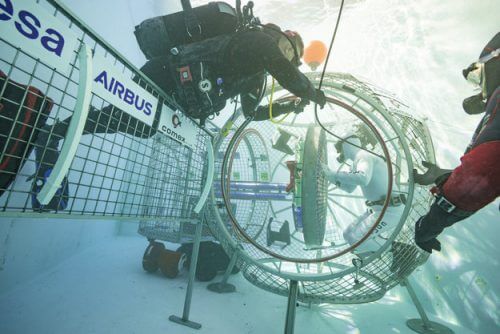Assembly of a new habitable structure close to the moon, called the transit station, is scheduled to begin in 2023. The international project will allow humans to explore farther than ever before and it brings new opportunities for European planning in space.

Underwater test of a possible sample of the ESPRIT airlock. Photo: Benjamin Schultz, for the European Space Agency
At the end of 2018 ESA (European Space Agency) established two corporations — one led by Airbus and the other Thales Alenia Space — to carry out parallel studies on the design of a scientific airlock. Similar to the Japanese Kubo experimental module on the International Space Station, this airlock will allow scientific experiments to be transferred from the transit station to and from outer space.
The scientific airlock is part of a European module called ESPRIT - a module that will also enable refueling and provide communication with the moon and the earth.
Although ESPRIT's development is still very early, ESA astronaut Jean-Francois Clairbois and ESA astronaut trainer Arva Stébanin recently had a hands-on opportunity to try out one of the airlock ideas in Marseille, France and see how it might work in space.
work under water
The model of ESPRIT's interior, designed and built by French company Comex for Airbus, was tested underwater to simulate the weightlessness of space.
The team, led by Peter Weiss, used XNUMXD-printed models to represent the equipment the astronauts would operate on the transit station. These included parts of the robotic arm that the Canadian Space Agency will develop for the transit station.
Comex diver Kathryn Novak says the main goals of the experiment were to evaluate requirements for the operation of METADs and to determine the best locations for two cameras that would allow watching activities from the ground.
"We wanted to see if the astronauts had enough space to install equipment on the docking table, perform the necessary tests and then transfer it through the lock channel for exposure to space," she explains. "We also wanted to make sure that the team members have a place to perform maintenance or repairs inside the lock and to see if additional interfaces with the team, such as railings, are necessary."
To ensure that the study was truly representative, Jean-Francois and Arva performed the experiment in synthetic rubber suits while breathing through a long menstrual tube attached to the surface.
ESA's director of research Philip Skonians says this was important to "simulate the environment of the transit station where the astronauts will be floating in their normal clothes".
First impressions
After spending 28 days in space over the course of three shuttle missions, Philippe says Jean-Francois was well suited to the experiment. Arva also logged seven hours in weightlessness when training astronauts in parabolic flights. These experiences allowed the two to evaluate the accessibility and ergonomics of the module.
"Through the experiment, we were able to confirm that this preliminary internal design would be suitable for the tasks that the astronauts are expected to perform in weightlessness and we identified the best places to put handrails to ensure optimal stability of the crew when they are handling the pods and activating the airlock," says Arva.
Philip says the team was also impressed by the large size of the scaffolds and the expected robotic interfaces.
"We saw the dimensions of these components in the documents, but after seeing full-scale XNUMXD printed models we could better understand that they are very large," says Philip. "This is something we will have to take into account throughout the process in terms of mass and power balance."
Go to the moon
So what exactly are the next steps? Philip says that for Airbus and Comex it was a fact-finding mission. They will now use the results of the experiment to refine their idea and optimize the sample.
Thales Alenia Space will also continue to work on its air shoe concept and ESA intends to issue a competitive request for proposals in the summer. At this stage the two companies will be asked to present their ideas and costings to be considered before the next ESA Ministerial Council meeting in November.
to the announcement of the European Space Agency
More of the topic in Hayadan:
